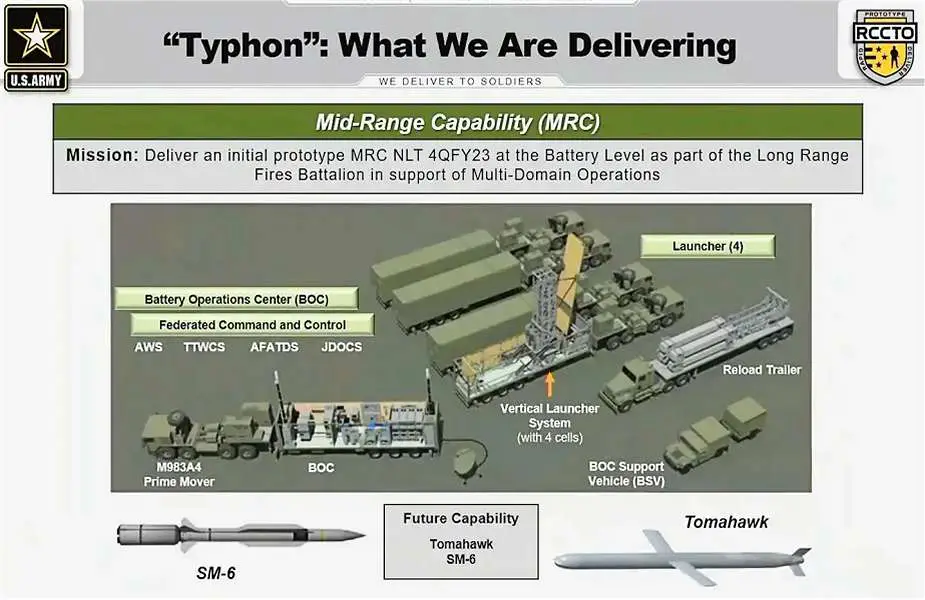US Plans to Deploy Ground-Based Missile Launcher Systems in Indo-Pacific Region Amid North Korea Threats
The United States announced plans to deploy ground-based missile launchers in the Indo-Pacific region, capable of firing advanced SM-6 and Tomahawk missiles. This development was confirmed in an interview with U.S. Army General Charles Flynn, the commanding general of U.S. Army Pacific, published by the South Korean News Agency Yonhap on April 7, 2024. The deployment aims to address the increasing security threats in the region.
Follow Army Recognition on Google News at this link

The new U.S. Army land-based missile launcher system will be able to fire SM-6 and Tomahawk missiles. (Picture source U..S. DoD)
General Flynn, the commanding general of U.S. Army Pacific, highlighted the U.S. Army's development of "long-range precision fires" as a strategic response, with the SM-6 interceptor and the maritime-strike Tomahawk missiles identified as key components of the new launch system. This marks the first official confirmation of the types of weapon systems to be stationed in the region this year.
The SM-6 (Standard Missile 6) is a highly adaptable and multi-role naval missile developed by Raytheon Technologies, designed to offer comprehensive fleet air defense against a wide array of threats including fixed- and rotary-wing aircraft, unmanned aerial vehicles, cruise missiles, and even against terminal phase ballistic missiles in its advanced configurations. It exhibits formidable anti-air warfare (AAW), anti-surface warfare (ASuW), and terminal ballistic missile defense (TBMD) capabilities. The missile incorporates both active and semi-active guidance systems, enabling it to prosecute targets beyond the radar horizon with the aid of the Aegis Combat System.
The SM-6 missile stands out for its extended engagement range, capable of reaching targets up to 450 km (240 nautical miles), facilitated by its advanced propulsion mechanism, cutting-edge radar detection, and signal processing capabilities. Its network-enabled approach allows for seamless integration with other assets for coordinated fire control, significantly elevating its combat efficacy and making it a pivotal element in contemporary naval defense strategies.
The Tomahawk cruise missile is a highly sophisticated, long-range precision-guided munition used by the United States Navy and Royal Navy. Designed for land-attack warfare, the Tomahawk is capable of striking high-value or heavily defended land targets from extended distances. Its versatility allows for launch from a variety of platforms, including surface ships, submarines, and ground-based launchers, enhancing its strategic utility across multiple domains. With a range of approximately 1,000 miles (about 1,609 kilometers), the Tomahawk can navigate to its target autonomously, using advanced guidance systems such as TERCOM (Terrain Contour Matching) and DSMAC (Digital Scene Matching Area Correlator) to maintain low altitude and reduce detection.
The Tomahawk missile can be equipped with conventional or nuclear warheads, making it a flexible tool in both strategic deterrence and conventional strike operations. The missile's ability to be reprogrammed in-flight for precision targeting and its proven combat effectiveness have made the Tomahawk a cornerstone of U.S. and allied cruise missile capabilities since its introduction in the 1980s.
Speculation among defense experts suggests that the deployment could involve the ground-based Typhon system, which the U.S. Army has operated since last year. Guam, a strategic U.S. territory in the Western Pacific Ocean, is reported by Japanese media as a potential site for the system.
This deployment marks a pivotal shift in U.S. military strategy in the region, being the first of its kind since the 1987 treaty with the former Soviet Union, which banned Intermediate-Range Nuclear Forces (INF). The U.S. withdrawal from the INF treaty in 2019, citing Russian violations, has paved the way for the development and deployment of new intermediate-range missiles in response to China's assertive actions in the Indo-Pacific.
The announcement comes days after North Korea's test-fire of a new hypersonic intermediate-range ballistic missile, the Hwasongpho-16B, on April 3, 2024. North Korea claims its missiles are now solid-fuel and nuclear-capable, with enhanced warhead control capabilities. Hypersonic missiles pose a challenge to existing missile defense systems due to their high speed, ability to change flight paths, and low-altitude flight.
In response to these developments, the U.S. Forces Korea continues to operate PAC-3 and THAAD missile defense systems, complemented by South Korea's Cheongung mid-tier defense system. However, there are growing concerns over North Korea's advancing weapons programs, allegedly supported by Moscow in exchange for military supplies.
This strategic deployment by the U.S. underscores the escalating tensions and complex security dynamics in the Indo-Pacific region, signaling a robust effort to maintain stability and deter potential aggressors.
Defense News April 2024
- Hits: 2579
















